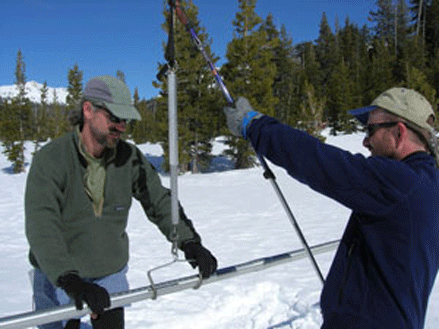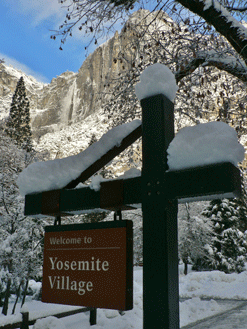Yosemite brought in the New Year wearing a sparkling white gown of snow, left from a series of storms near the end of December. At one point, there was 14 inches on the ground in Yosemite Valley and much of that has stuck around as daily temperatures have been fairly cold. The snow certainly produced hazardous driving conditions as well as beautiful photos as the park was transformed into a winter wonderland. Yosemite is a different park in winter, a different Yosemite, and visitors this time of year get to see that first hand.
This was the first major deposit of snow into the largest water reservoir in California. The Sierra Nevada snowpack, including Yosemite, makes up at least 50% of the water used in California each year. This fact was not lost on Californians a century ago when the increased need of water for agricultural and population growth was apparent. A survey of the snowpack was needed to help anticipate yearly fluctuations in the amount of water available. The tools and methodology to do such a survey were developed in 1909 by Dr. James Edward Church of the University of Nevada at Reno. The Mount Rose snow tube was the first instrument designed to measure the water content of snow, and is still used by our surveyors today. Simply, the tube has an inner diameter of 1.485 inches, which means that every inch of water inside weighs one ounce.By pushing this tube into the snowpack until it hits the ground and then weighing it with the core of snow inside, you can calculate how many inches of water are sitting on the ground.
As the techniques for water resources forecasting were refined, snow courses were set up throughout the Sierra to standardize the measurement locations. Today Yosemite has thirteen of these snow courses, some of which date back to 1930. Most are located at isolated high-elevation areas that require backcountry travel by ski or snowshoe to reach. These snow courses are typically measured on the first of February, March, April, and May, with our peak snowpack expected in April.
While the snow courses in Yosemite have yet to be measured, data from other locations in the Sierra indicate that we began the New Year with above average snowpack. Of course, the majority of our snowpack comes in three to five winter storms and missing just one could seriously impact the amount of water we will have for the rest of the year. We will have to wait until April 1 to get a more complete picture and a lot can happen, or not happen, in three months in the Sierra.
 |
 |
|
A winter snow survey using the Mount Rose snow tube. |
Yosemite Village under a fresh blanket of snow |
